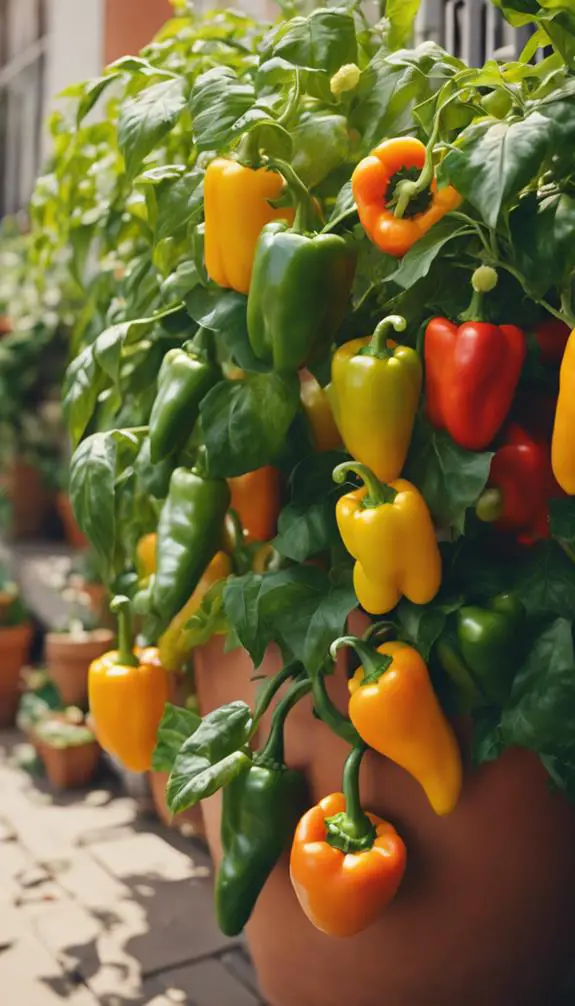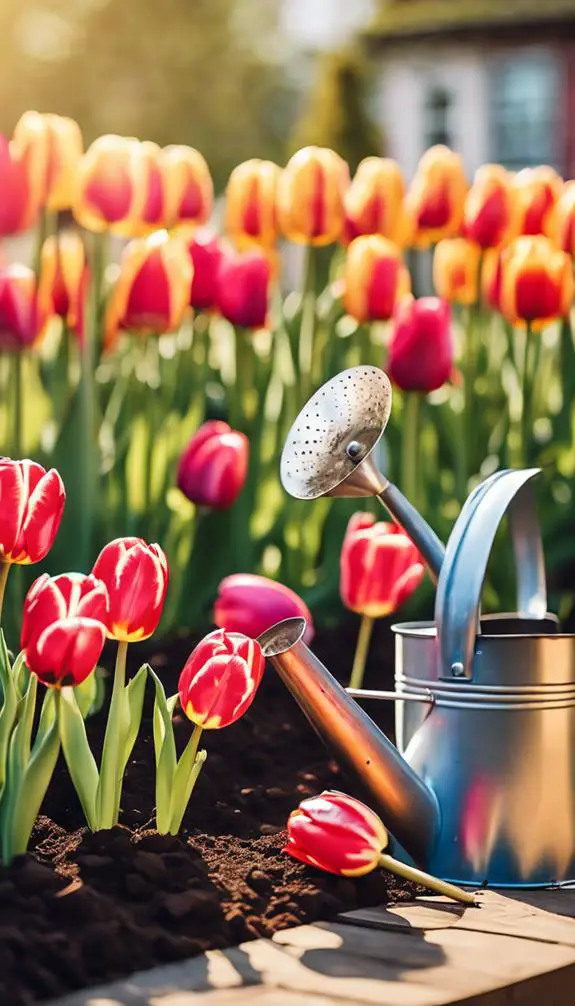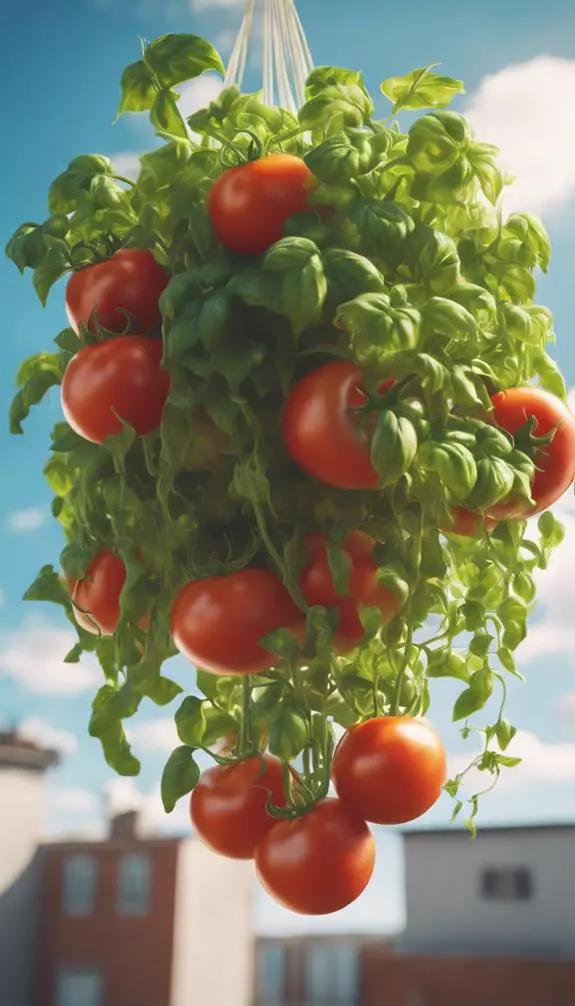As you prepare to grow sweet peppers in pots, you're likely wondering where to start. Selecting the right variety is vital, but it's just the beginning. You'll need to guarantee your pot and soil are up to par, and then it's time to sow those seeds. But what's the ideal soil pH, and how often should you water? With the right guidance, you can coax a bountiful harvest from your potted peppers, but without it, you might be left with nothing but disappointment. Let's delve into the specifics to guarantee a successful and flavorful crop.
Summary
- Select sweet pepper varieties bred for compact growth and high yields in small spaces, with a bushy growth habit and vibrant color patterns.
- Plant seeds at the ideal depth (about ¼ inch) and soil temperature (around 75°F to 85°F) for successful germination and seedling development.
- Use a well-balanced potting mix with a pH between 6.0 and 6.8, and a breathable pot with good drainage holes to prevent waterlogging.
- Water deeply but infrequently, maintaining ideal moisture levels, and provide at least 6 hours of direct sunlight daily for prime growth.
- Fertilize with a balanced diet of nutrients, prune regularly to promote bushy growth, and provide support with pepper stakes or trellises to encourage fruiting.
Choosing the Right Variety

What makes one sweet pepper variety better suited for container growing than another?
You'll want to weigh, as certain varieties have been bred specifically for compact growth and high yields in small spaces.
Look for varieties with a dwarf or compact growth habit, as they'll require less pruning and support. Color patterns also play a role, with some sweet peppers displaying vibrant hues that add visual interest to your container garden.
For instance, 'Thai Hot' and 'Bird's Eye' peppers feature stunning yellow and orange stripes, respectively.
When choosing a variety, prioritize those with a bushy growth habit, as they'll provide better coverage and produce more fruit in a pot.
Selecting the Perfect Pot
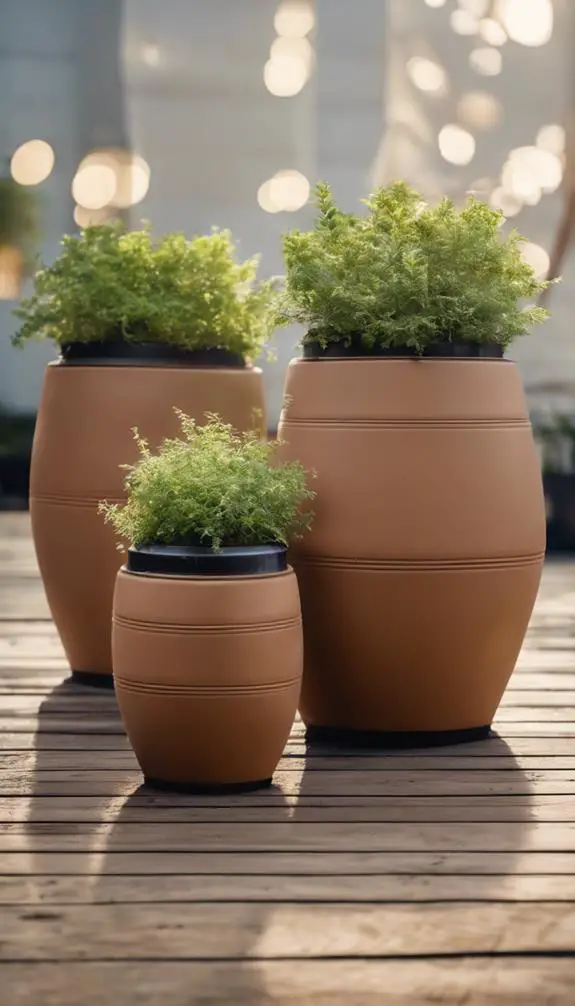
You've selected a sweet pepper variety that's perfect for container growing, now it's time to think about the pot itself.
When it comes to pot size, a minimum of 5-7 gallons is recommended to provide enough room for the roots to grow. This will guarantee your pepper plant receives adequate nutrients and water.
Material considerations are also vital. Look for pots made from breathable materials like terra cotta, ceramic, or wood to promote healthy root growth.
Avoid using plastic or metal pots, as they can retain too much heat and cause root damage. Additionally, consider pots with good drainage holes to prevent waterlogged soil.
Soil Requirements for Peppers
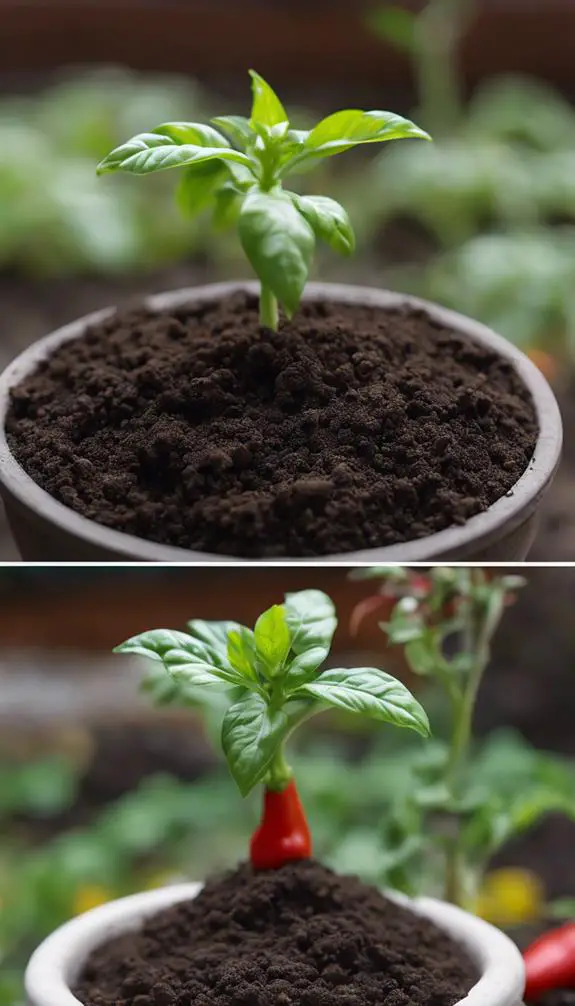
You'll want to create a well-balanced soil composition that caters to your pepper plants' needs, as they thrive in specific conditions.
The ideal pH level for peppers falls between 6.0 and 6.8, so you'll need to verify your potting mix meets this requirement.
Additionally, a vital drainage system is essential to prevent waterlogged soil, which can be detrimental to your pepper plants' health.
Soil Composition Matters
Sweet pepper plants thrive in well-draining, fertile soil with a pH between 6.0 and 6.8, making soil composition a critical factor in their growth.
You'll want to create a soil structure that allows for good aeration and water penetration. To achieve this, mix in organic amendments like compost, peat moss, or perlite to improve soil structure and fertility.
These additives will help retain moisture, suppress diseases, and provide essential nutrients. Aim for a balanced blend of 60% peat moss, 20% perlite, and 20% vermiculite.
This combination will provide the ideal environment for your sweet pepper plants to flourish. By getting the soil composition right, you'll be well on your way to growing healthy, productive sweet pepper plants in pots.
Pepper-Friendly Ph Levels
With sweet pepper plants being sensitive to pH levels, it's crucial to maintain a narrow pH range to guarantee ideal growth.
pH levels outside the ideal range can lead to nutrient deficiencies, reduced growth, and increased susceptibility to disease.
You'll want to aim for a pH between 6.0 and 6.8, as this allows for peak nutrient uptake.
Sweet peppers have low alkaline tolerance, so it's imperative to avoid alkaline soils.
On the other hand, they can thrive in slightly acidic soils.
If your potting mix is too acidic, you can adjust the pH by adding lime or wood ash.
Conversely, if it's too alkaline, add peat moss or sulfur to lower the pH.
Optimal Drainage Systems
In a well-draining pot, the soil's sponge-like texture allows water to penetrate and escape, preventing waterlogged soil conditions that can be detrimental to sweet pepper plants.
You can achieve ideal drainage by incorporating a French drain system, which involves adding a layer of small rocks or pebbles at the bottom of the pot.
This allows excess water to drain freely, reducing the risk of root rot.
Additionally, consider adding drainage layers, such as a mix of perlite and vermiculite, to improve soil aeration and water penetration.
Sowing Sweet Pepper Seeds

You'll want to choose sweet pepper seeds that are resistant to common pests and diseases, and suitable for container growing.
When sowing, make sure to plant them at the ideal depth, typically ¼ inch, to guarantee proper germination. Additionally, soil temperature plays a vital role, with sweet peppers requiring a warm start of around 75°F to 85°F (24°C to 30°C) for successful seedling development.
Seed Selection Criteria
Frequently, sweet pepper enthusiasts overlook the significance of seed selection, which can make or break the success of their potted peppers.
You should choose seeds that are fresh, as old seeds may have lower germination rates or produce weaker plants. Hybrid seeds are a great option, as they offer improved disease resistance, higher yields, and more uniform fruit.
When selecting seeds, look for varieties specifically bred for container growing, as they tend to be more compact and produce smaller fruit. Additionally, consider the days to maturity, as some sweet pepper varieties can take over 90 days to ripen.
Optimal Sowing Depth
Your seed packet's sowing instructions may seem like a minor detail, but it's essential to get it right.
Sowing sweet pepper seeds at the correct depth is pivotal for successful germination. Check your seed packet for specific seed depth guidelines, as they vary between varieties.
A general rule of thumb is to sow seeds 1/4 to 1/2 inch deep. Sowing mistakes, such as planting too deeply, can lead to poor germination rates or weak seedlings.
Make sure to sow seeds at the recommended depth to give them the best chance of growing into healthy, productive plants. Remember, precision is key when it comes to sowing sweet pepper seeds.
Soil Temperature Matters
Most sweet pepper varieties require a minimum soil temperature of around 75°F (24°C) to germinate successfully.
You can guarantee ideal soil temperature by using a soil thermometer to monitor the temperature.
Temperature fluctuations can be detrimental to germination, so maintaining a consistent temperature is crucial.
If your potting mix is too cool, consider using a heating mat or warm location to raise the temperature.
Conversely, if the temperature is too high, provide shade or ventilation to cool it down.
Watering and Humidity Needs

About 70% of a sweet pepper plant's weight is comprised of water, making consistent moisture a crucial component of its growth.
You'll want to maintain ideal moisture levels by watering your potted sweet pepper plant when the top 1-2 inches of soil feel dry to the touch. Avoid overwatering, which can lead to root rot and reduced water absorption.
Instead, water deeply but infrequently to encourage deep root growth. You can also cover the pot with a tray filled with water and pebbles to increase the humidity around the plant, promoting healthy growth.
Monitor the plant's response to watering and adjust your schedule as needed to guarantee the right balance of moisture.
Providing Adequate Sunlight

You'll want to position your potted sweet peppers in a spot that receives direct sunlight for at least 6 hours a day.
A south-facing window spot is ideal, as it provides the most intense sunlight.
For peak growth, aim to give your peppers morning sun exposure, as this is when they'll benefit most from the sun's rays.
South-Facing Window Spots
When situating your potted sweet pepper plants, prioritize south-facing window spots that receive direct sunlight for at least 6 hours daily.
This orientation guarantees maximum sunlight exposure, which sweet peppers crave.
To determine the best window spot, conduct brightness tests by holding a piece of white paper near the window.
If the paper appears bright white, the area receives sufficient sunlight.
Consider the window's orientation: south-facing windows receive more intense sunlight than east- or west-facing ones.
Avoid north-facing windows, as they receive limited sunlight.
Direct Sunlight Duration
The duration of direct sunlight your sweet pepper plants receive substantially impacts their growth and productivity.
To facilitate prime growth, aim to provide at least 6 hours of direct sunlight daily. However, if you can manage it, 8-10 hours of direct sunlight will yield even better results.
Pay attention to sunlight timing as well, since sweet peppers need intense sunlight during the fruiting stage.
During this stage, it's vital to provide consistent sunlight hours to promote healthy fruit development. Be mindful of the time of day you're providing sunlight, as afternoon sunlight tends to be more intense than morning sunlight.
Morning Sun Exposure
Morning sunlight, being gentler than afternoon sun, is ideal for sweet pepper plants during their early growth stages.
As an early riser, you can capitalize on this by positioning your pots to receive morning sun exposure. Aim for at least 2-3 hours of direct morning sunlight, which will help promote healthy leaf growth and development.
As sweet peppers mature, they'll become sun worshippers, requiring more intense sunlight. However, during the early stages, gentle morning sunlight is essential.
Fertilizing Your Peppers
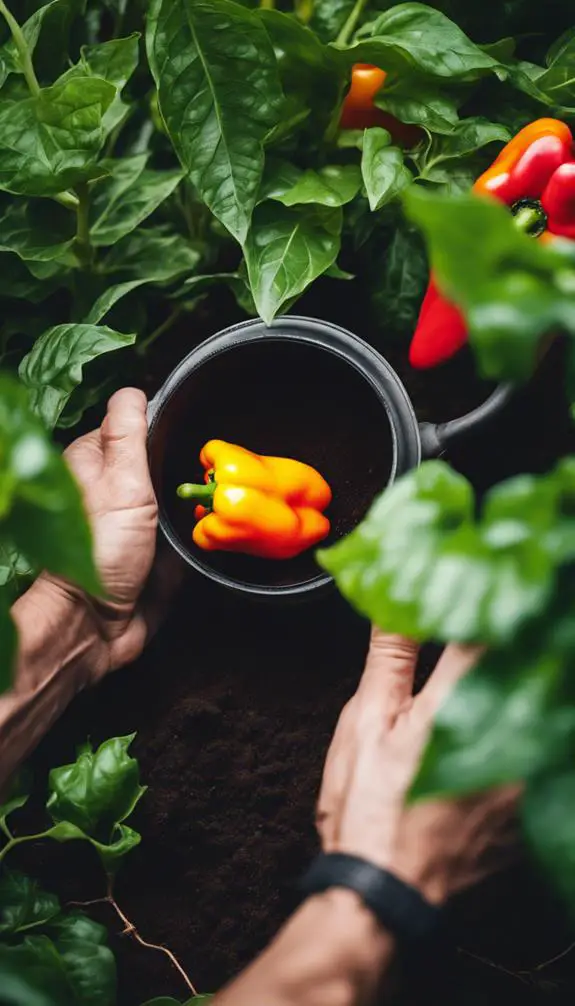
You'll want to fuel your sweet pepper plants with a balanced diet of nutrients to promote healthy growth and maximize yields.
Pepper nutrition is vital, and a well-timed fertilizer application can make all the difference. For peak results, use a water-soluble fertilizer with a balanced N-P-K ratio (20-20-20).
You can start fertilizing once your seedlings have two sets of leaves, and then follow a schedule of every 1-2 weeks. Fertilizer timing is key – avoid fertilizing during periods of extreme heat or when the plants are under stress.
Also, be cautious not to over-fertilize, as this can lead to weak and leggy growth. By providing your peppers with a steady supply of nutrients, you'll be rewarded with a bountiful harvest of sweet, crunchy peppers.
Pruning for Optimal Growth

Pruning your sweet pepper plants is a crucial step in promoting ideal growth, increasing yields, and encouraging bushy development.
By implementing effective pruning strategies, you'll stimulate your plant to produce more fruit-bearing branches, resulting in a bountiful harvest.
Establish a pruning schedule to maintain your plant's shape and promote healthy growth.
Start by removing lower leaves to prevent fungal diseases and encourage air circulation.
Next, trim back the terminal bud to encourage branching.
Continue pruning every 1-2 weeks, removing weak or spindly growth to direct the plant's energy towards fruit production.
A well-pruned sweet pepper plant will reward you with a higher yield and better fruit quality.
Supporting the Pepper Plant

As your sweet pepper plant grows, it will need support to maintain its shape and promote ideal fruiting.
You'll want to provide a structure for the plant to climb on, as sweet peppers are naturally vining. One option is to use pepper stakes, which can be placed near the base of the plant and gently tied to the stem as it grows.
Alternatively, you can train your pepper plant to climb up a plant trellis, which can be placed in the pot or container. This won't only keep the plant upright but also encourage better air circulation and sunlight penetration, leading to healthier growth and more abundant fruit production.
Pest Control and Prevention
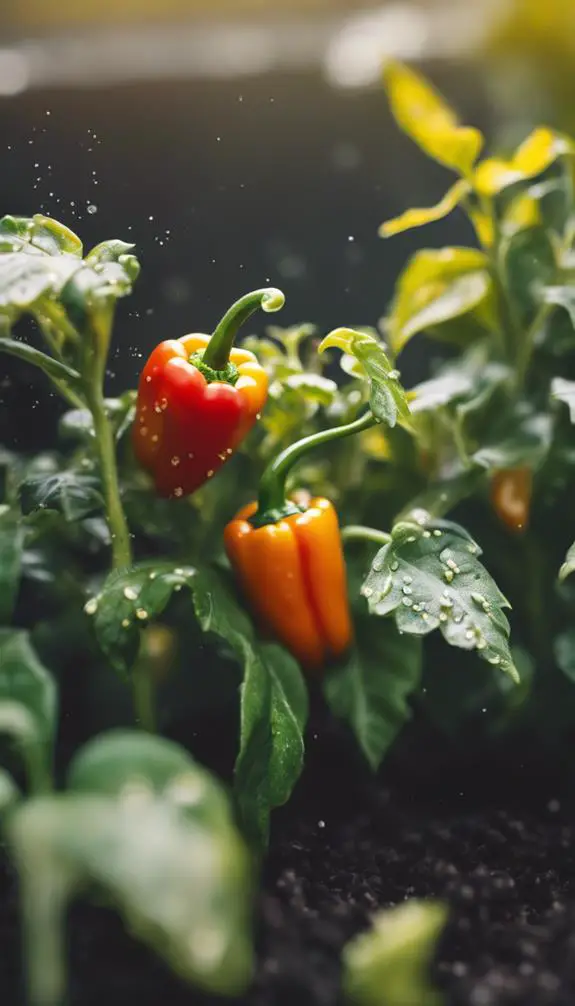
Pests can quickly destroy your sweet pepper crop, so it's vital to take proactive measures for pest control and prevention.
Check your plants regularly for signs of infestation, such as holes in leaves, white powdery residue, or actual pests on the plant.
Use physical barriers like fine-mesh screens to keep whiteflies and aphids away.
For more severe infestations, employ organic pesticides like insecticidal soap or neem oil.
These gentle yet effective solutions won't harm beneficial insects or the environment.
Spray them on your plants according to the product's instructions to eliminate pests and prevent re-infestation.
Common Diseases to Watch For
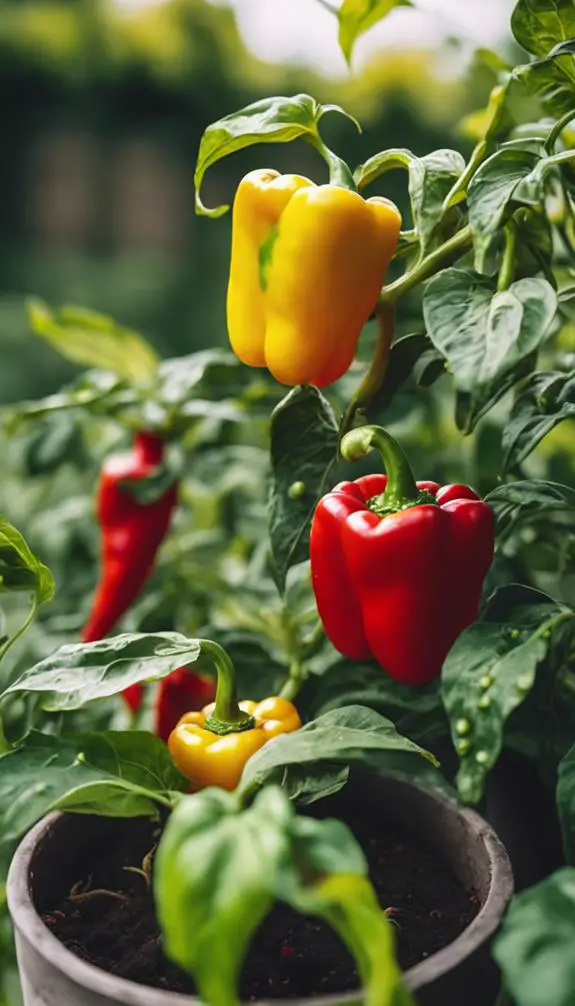
Fungal diseases, bacterial infections, and viral contagions can all wreak havoc on your sweet pepper crop, so it's crucial to be aware of the common diseases that can affect your plants.
Fungal infections like powdery mildew and root rot can cause white, powdery growth on leaves and stems, or soften and decay roots, respectively.
Bacterial blights, such as bacterial leaf spot, can lead to small, dark lesions on leaves that can spread quickly.
Regularly inspect your plants for signs of disease, and remove infected areas to prevent the spread. Guarantee good air circulation, water carefully, and maintain a clean potting environment to reduce the risk of disease.
Harvesting Sweet Peppers
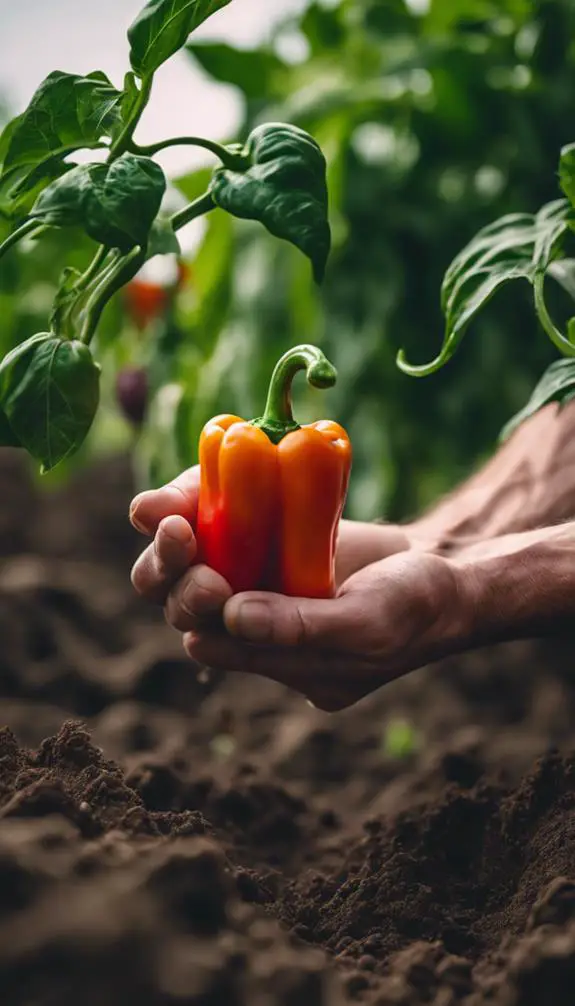
With your sweet peppers finally reaching maturity, this is vital to harvest them at the right time to enjoy their peak flavor and texture.
Check for pepper ripeness by gently tugging on the fruit; a ripe pepper will come off the plant easily. You can also inspect the color, as sweet peppers typically turn from green to their final color, which can range from yellow to orange, red, or purple.
Harvest your peppers regularly to encourage the plant to produce more fresh picks. Avoid squeezing or pulling the peppers, as this can damage the plant or the fruit. Instead, use scissors or a sharp knife to snip off the pepper, leaving a small piece of stem attached.
Overwintering Pepper Plants
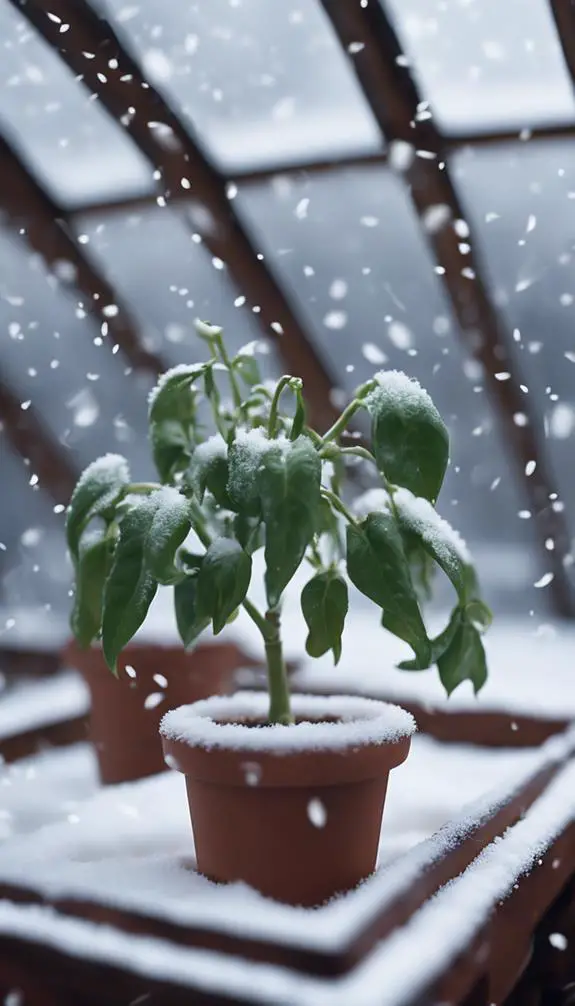
Bring your potted pepper plants indoors before the first frost to overwinter them, giving yourself a head start on next year's crop.
During this period, reduce watering and fertilization, as the plants require less energy.
Prune back the plant to about 6-8 inches from the soil, promoting new growth and preventing disease.
Provide bright, indirect light and maintain a temperature between 50-60°F (10-15°C) for ideal winter care.
Implement protection techniques like mulching or covering the pot with a breathable cloth to shield the roots from freezing temperatures.
FAQs
Can I Grow Sweet Peppers Indoors Year-Round?
You can successfully grow sweet peppers indoors year-round by replicating ideal outdoor conditions, maintaining a consistent indoor climate between 65-75°F, and providing perfect lighting conditions with 12-14 hours of indirect sunlight or LED grow lights.
How Do I Avoid Cross-Pollination With Other Pepper Varieties?
To prevent cross-pollination, you'll implement pollinator isolation by separating pepper varieties by at least 10 feet or using fine-mesh bags to contain pollinators, and practice variety segregation by dedicating tools and space to each variety.
Will Sweet Peppers Grow Well in Shaded Areas?
You'll find that sweet peppers exhibit moderate shade tolerance, but ideal growth requires partial sunlight, ideally 4-6 hours of direct sun or 8-10 hours of indirect light, to promote healthy development and maximize fruit production.
Can I Use Pepper Seeds From Store-Bought Peppers?
You can try using seeds from store-bought peppers, but their viability may be low due to unknown storage conditions and handling. For best results, store seeds properly in a cool, dry place to maintain their germination capacity.
Are Sweet Peppers Suitable for Hydroponic Gardening?
You'll find sweet peppers thrive in hydroponic systems, leveraging hydroponic benefits like precise Nutrient delivery, which boosts yields and flavor intensity, making them an ideal crop for innovative growers seeking optimized results.
Conclusion
You've successfully navigated the process of growing sweet peppers in pots. By choosing the right variety, providing ideal growing conditions, and monitoring for pests and diseases, you've set yourself up for a bountiful harvest. Remember to prune regularly, fertilize every 1-2 weeks, and support your plant with a stake or trellis. With proper care, your pepper plant will thrive and continue to produce delicious sweet peppers throughout the growing season.


